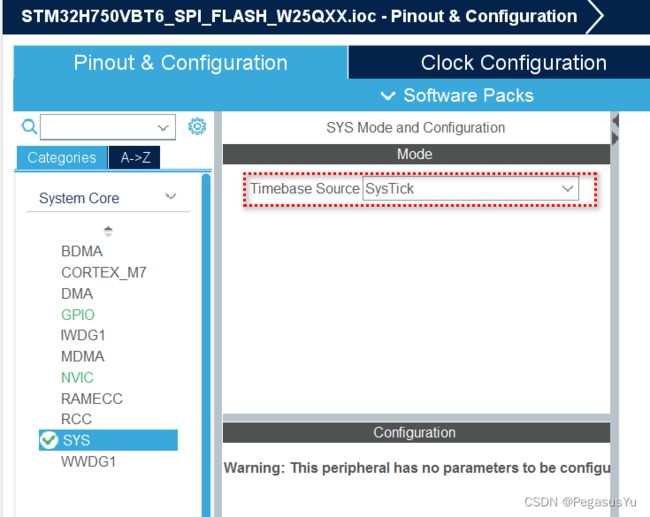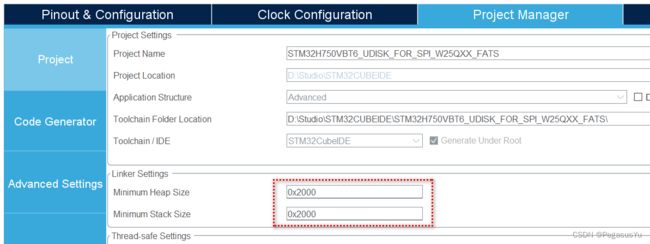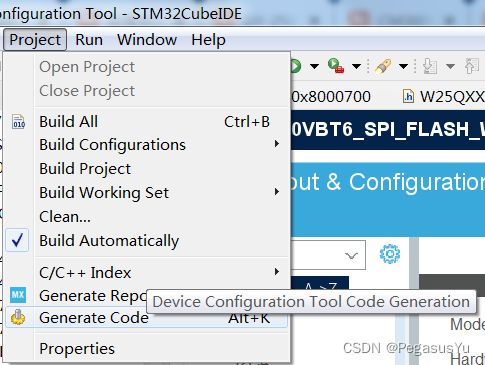STM32存储左右互搏 SPI总线读写FLASH W25QXX
STM32存储左右互搏 SPI总线读写FLASH W25QXX
FLASH是常用的一种非易失存储单元,W25QXX系列Flash有不同容量的型号,如W25Q64的容量为64Mbit,也就是8MByte。这里介绍STM32CUBEIDE开发平台HAL库操作W25Q各型号FLASH的例程。
W25QXX介绍
W25QXX的SOIC封装如下所示,在采用SPI而不是QUAL SPI时,管脚定义为:
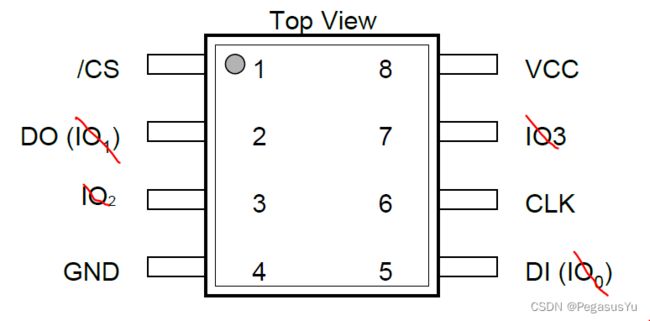
即由片选(/CS), 时钟(CLK), 数据输出(DO)和数据输入(DI)的组成4线SPI信号接口。VCC和GND提供电源和接地连接。
例程采用STM32H750VBT6芯片, FLASH可以选择为8/16/32/64/128/256/512/1024 Mbit的W25Q型号。
STM32工程配置
选择硬件接口SPI2为FLASH连接接口,片选采用软件代码控制方式,单独设置为输出GPIO:



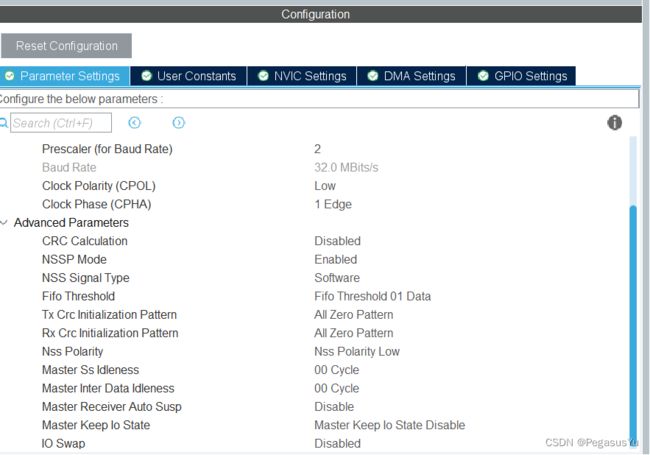
不采用中断和DMA方式,需要时可以再添加,调用相对应的操作库函数及补充中断处理函数即可。

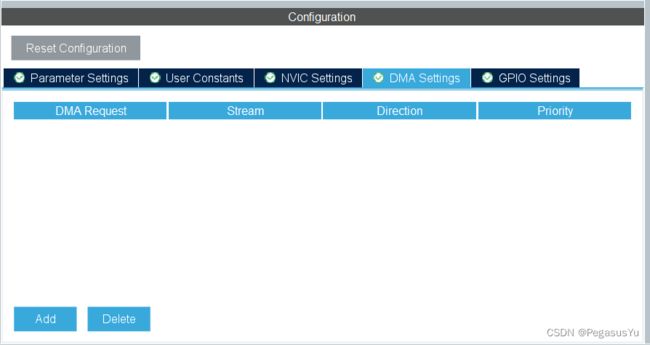
配置UART1用于控制打印:


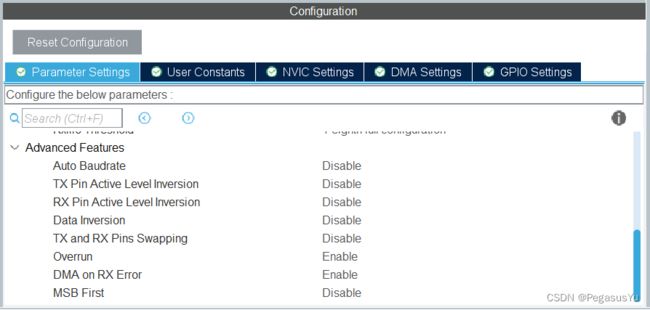


STM32H7资源较多,可以将堆栈开大:
STM32工程代码
UART串口printf打印输出实现参考:STM32 UART串口printf函数应用及浮点打印代码空间节省 (HAL)
建立W25Q访问的库头文件W25QXX.h:
#ifndef INC_W25QXX_H_
#define INC_W25QXX_H_
#include "main.h"
uint8_t SPI2_ReadWriteByte(uint8_t TxData);
//W25QXX serial chip list:
#define W25Q20_ID 0XEF11
#define W25Q40_ID 0XEF12
#define W25Q80_ID 0XEF13
#define W25Q16_ID 0XEF14
#define W25Q32_ID 0XEF15
#define W25Q64_ID 0XEF16
#define W25Q128_ID 0XEF17
#define W25Q256_ID 0XEF18
#define W25Q512_ID 0XEF19
#define W25Q1024_ID 0XEF20
extern uint16_t W25QXX_TYPE; //To indicate W25QXX type used in this procedure
//W25QXX chip select control function
#define W25QXX_CS(n) ( n ? HAL_GPIO_WritePin(GPIOB, GPIO_PIN_12, GPIO_PIN_SET) : HAL_GPIO_WritePin(GPIOB, GPIO_PIN_12, GPIO_PIN_RESET) )
//command table for W25QXX access
#define W25X_WriteEnable 0x06
#define W25X_WriteDisable 0x04
#define W25X_ReadStatusReg1 0x05
#define W25X_ReadStatusReg2 0x35
#define W25X_ReadStatusReg3 0x15
#define W25X_WriteStatusReg1 0x01
#define W25X_WriteStatusReg2 0x31
#define W25X_WriteStatusReg3 0x11
#define W25X_ReadData 0x03
#define W25X_FastReadData 0x0B
#define W25X_FastReadDual 0x3B
#define W25X_PageProgram 0x02
#define W25X_BlockErase 0xD8
#define W25X_SectorErase 0x20
#define W25X_ChipErase 0xC7
#define W25X_PowerDown 0xB9
#define W25X_ReleasePowerDown 0xAB
#define W25X_DeviceID 0xAB
#define W25X_ManufactDeviceID 0x90
#define W25X_JedecDeviceID 0x9F
#define W25X_Enable4ByteAddr 0xB7
#define W25X_Exit4ByteAddr 0xE9
uint8_t W25QXX_Init(void);
uint16_t W25QXX_ReadID(void); //Read W25QXX ID
uint8_t W25QXX_ReadSR(uint8_t reg_num); //Read from status register
void W25QXX_4ByteAddr_Enable(void); //Enable 4-byte address mode
void W25QXX_Write_SR(uint8_t reg_num,uint8_t d); //Write to status register
void W25QXX_Write_Enable(void); //Write enable
void W25QXX_Write_Disable(void); //Write disable
void W25QXX_Write_NoCheck(uint8_t* pBuffer,uint32_t WriteAddr,uint16_t NumByteToWrite); //Write operation w/o check
void W25QXX_Read(uint8_t* pBuffer,uint32_t ReadAddr,uint16_t NumByteToRead); //Read operation
void W25QXX_Write(uint8_t* pBuffer,uint32_t WriteAddr,uint16_t NumByteToWrite); //Write operation
void W25QXX_Erase_Chip(void); //Erase whole chip
void W25QXX_Erase_Sector(uint32_t Sector_Num); //Erase sector in specific sector number
void W25QXX_Wait_Busy(void); //Wait idle status before next operation
void W25QXX_PowerDown(void); //Enter power-down mode
void W25QXX_WAKEUP(void); //Wake-up
#endif /* INC_W25QXX_H_ */
建立W25Q访问的库源文件W25QXX.c:
#include "W25QXX.h"
extern SPI_HandleTypeDef hspi2;
extern void PY_Delay_us_t(uint32_t Delay);
//Write and read one byte in SPI2
uint8_t SPI2_ReadWriteByte(uint8_t TxData)
{
uint8_t Rxdata;
HAL_SPI_TransmitReceive(&hspi2,&TxData,&Rxdata,1, 1000);
return Rxdata;
}
uint16_t W25QXX_TYPE=W25Q64_ID;
//W25QXX initialization
uint8_t W25QXX_Init(void)
{
uint8_t temp;
W25QXX_CS(1);
W25QXX_TYPE=W25QXX_ReadID();
if((W25QXX_TYPE==W25Q256_ID)||(W25QXX_TYPE==W25Q512_ID)||(W25QXX_TYPE==W25Q1024_ID))
{
temp=W25QXX_ReadSR(3); //read status register 3
if((temp&0X01)==0) //judge address mode and configure to 4-byte address mode
{
W25QXX_CS(0);
SPI2_ReadWriteByte(W25X_Enable4ByteAddr);
W25QXX_CS(1);
}
}
if((W25QXX_TYPE==0x0000)||(W25QXX_TYPE==0xFFFF)) return 0;
else return 1;
}
//Read status registers of W25QXX
//reg_num: register number from 1 to 3
//return: value of selected register
//SR1 (default 0x00):
//BIT7 6 5 4 3 2 1 0
//SPR RV TB BP2 BP1 BP0 WEL BUSY
//SPR: default 0, status register protection bit used with WP
//TB,BP2,BP1,BP0: FLASH region write protection configuration
//WEL: write enable lock
//BUSY: busy flag (1: busy; 0: idle)
//SR2:
//BIT7 6 5 4 3 2 1 0
//SUS CMP LB3 LB2 LB1 (R) QE SRP1
//SR3:
//BIT7 6 5 4 3 2 1 0
//HOLD/RST DRV1 DRV0 (R) (R) WPS ADP ADS
uint8_t W25QXX_ReadSR(uint8_t reg_num)
{
uint8_t byte=0,command=0;
switch(reg_num)
{
case 1:
command=W25X_ReadStatusReg1; //To read status register 1
break;
case 2:
command=W25X_ReadStatusReg2; //To read status register 2
break;
case 3:
command=W25X_ReadStatusReg3; //To read status register 3
break;
default:
command=W25X_ReadStatusReg1;
break;
}
W25QXX_CS(0);
SPI2_ReadWriteByte(command); //send command
byte=SPI2_ReadWriteByte(0Xff); //read data
W25QXX_CS(1);
return byte;
}
//Write status registers of W25QXX
//reg_num: register number from 1 to 3
//d: data for updating status register
void W25QXX_Write_SR(uint8_t reg_num,uint8_t d)
{
uint8_t command=0;
switch(reg_num)
{
case 1:
command=W25X_WriteStatusReg1; //To write status register 1
break;
case 2:
command=W25X_WriteStatusReg2; //To write status register 2
break;
case 3:
command=W25X_WriteStatusReg3; //To write status register 3
break;
default:
command=W25X_WriteStatusReg1;
break;
}
W25QXX_CS(0);
SPI2_ReadWriteByte(command); //send command
SPI2_ReadWriteByte(d); //write data
W25QXX_CS(1);
}
//W25QXX write enable
void W25QXX_Write_Enable(void)
{
W25QXX_CS(0);
SPI2_ReadWriteByte(W25X_WriteEnable);
W25QXX_CS(1);
}
//W25QXX write disable
void W25QXX_Write_Disable(void)
{
W25QXX_CS(0);
SPI2_ReadWriteByte(W25X_WriteDisable);
W25QXX_CS(1);
}
//Read chip ID
//return:
//0XEF11 for W25Q20
//0XEF12 for W25Q40
//0XEF13 for W25Q80
//0XEF14 for W25Q16
//0XEF15 for W25Q32
//0XEF16 for W25Q64
//0XEF17 for W25Q128
//0XEF18 for W25Q256
uint16_t W25QXX_ReadID(void)
{
uint16_t Temp = 0;
W25QXX_CS(0);
SPI2_ReadWriteByte(0x90); //send command
SPI2_ReadWriteByte(0x00);
SPI2_ReadWriteByte(0x00);
SPI2_ReadWriteByte(0x00);
Temp|=SPI2_ReadWriteByte(0xFF)<<8; //read high byte data
Temp|=SPI2_ReadWriteByte(0xFF); //read low byte data
W25QXX_CS(1);
return Temp;
}
//Read W25QXX from specific address for specific byte length
//pBuffer: data buffer
//ReadAddr: specific address
//NumByteToRead: specific byte length (max 65535)
void W25QXX_Read(uint8_t* pBuffer,uint32_t ReadAddr,uint16_t NumByteToRead)
{
uint16_t i;
W25QXX_CS(0);
SPI2_ReadWriteByte(W25X_ReadData); //send read command
if((W25QXX_TYPE==W25Q256_ID)||(W25QXX_TYPE==W25Q512_ID)||(W25QXX_TYPE==W25Q1024_ID)) //send highest 8-bit address
{
SPI2_ReadWriteByte((uint8_t)((ReadAddr)>>24));
}
SPI2_ReadWriteByte((uint8_t)((ReadAddr)>>16)); //send 24-bit address
SPI2_ReadWriteByte((uint8_t)((ReadAddr)>>8));
SPI2_ReadWriteByte((uint8_t)ReadAddr);
for(i=0;i<NumByteToRead;i++)
{
pBuffer[i]=SPI2_ReadWriteByte(0XFF); //read data
}
W25QXX_CS(1);
}
//Write W25QXX not more than 1 page (256 bytes)
//pBuffer: data buffer
//WriteAddr: specific address
//NumByteToWrite: specific byte length (max 256)
void W25QXX_Write_Page(uint8_t* pBuffer,uint32_t WriteAddr,uint16_t NumByteToWrite)
{
uint16_t i;
W25QXX_Write_Enable(); //write enable
W25QXX_CS(0);
SPI2_ReadWriteByte(W25X_PageProgram); //send write command
if((W25QXX_TYPE==W25Q256_ID)||(W25QXX_TYPE==W25Q512_ID)||(W25QXX_TYPE==W25Q1024_ID)) //send highest 8-bit address
{
SPI2_ReadWriteByte((uint8_t)((WriteAddr)>>24));
}
SPI2_ReadWriteByte((uint8_t)((WriteAddr)>>16)); //send 24-bit address
SPI2_ReadWriteByte((uint8_t)((WriteAddr)>>8));
SPI2_ReadWriteByte((uint8_t)WriteAddr);
for(i=0;i<NumByteToWrite;i++)SPI2_ReadWriteByte(pBuffer[i]); //write data
W25QXX_CS(1);
W25QXX_Wait_Busy();
}
//Write W25QXX w/o erase check and w/o byte number restriction
//pBuffer: data buffer
//WriteAddr: specific address
//NumByteToWrite: specific byte length (max 65535)
void W25QXX_Write_NoCheck(uint8_t* pBuffer,uint32_t WriteAddr,uint16_t NumByteToWrite)
{
uint16_t remained_byte_num_in_page;
remained_byte_num_in_page=256-WriteAddr%256; //remained byte number in page
if( NumByteToWrite <= remained_byte_num_in_page ) remained_byte_num_in_page = NumByteToWrite; //data can be written in single page
while(1)
{
W25QXX_Write_Page(pBuffer,WriteAddr,remained_byte_num_in_page);
if(NumByteToWrite==remained_byte_num_in_page)break; //end write operation
else //NumByteToWrite>remained_byte_num_in_page
{
pBuffer+=remained_byte_num_in_page;
WriteAddr+=remained_byte_num_in_page;
NumByteToWrite-=remained_byte_num_in_page;
if(NumByteToWrite>256)remained_byte_num_in_page=256; //for whole page write
else remained_byte_num_in_page=NumByteToWrite; //for non-whole page write
}
};
}
//Write W25QXX w/ erase after check and w/o byte number restriction
//pBuffer: data buffer
//WriteAddr: specific address
//NumByteToWrite: specific byte length (max 65535)
uint8_t W25QXX_BUFFER[4096];
void W25QXX_Write(uint8_t* pBuffer,uint32_t WriteAddr,uint16_t NumByteToWrite)
{
uint32_t secpos;
uint16_t secoff;
uint16_t secremain;
uint16_t i;
uint8_t * W25QXX_BUF;
W25QXX_BUF=W25QXX_BUFFER;
secpos=WriteAddr/4096; //sector number (16 pages for 1 sector) for destination address
secoff=WriteAddr%4096; //offset address in sector for destination address
secremain=4096-secoff; //remained space for sector
if(NumByteToWrite<=secremain)secremain=NumByteToWrite; //data can be written in single sector
while(1)
{
W25QXX_Read(W25QXX_BUF,secpos*4096,4096); //read sector data for ease necessity judgment
for(i=0;i<secremain;i++) //check sector data status
{
if(W25QXX_BUF[secoff+i]!=0XFF) break; //ease necessary
}
if(i<secremain) //for ease
{
W25QXX_Erase_Sector(secpos); //ease sector
for(i=0;i<secremain;i++) //data copy
{
W25QXX_BUF[i+secoff]=pBuffer[i];
}
W25QXX_Write_NoCheck(W25QXX_BUF,secpos*4096,4096); //write sector
}
else W25QXX_Write_NoCheck(pBuffer,WriteAddr,secremain); //write data for sector unnecessary to erase
if(NumByteToWrite==secremain)break; //for operation end
else //for operation continuing
{
secpos++; //sector number + 1
secoff=0; //offset address from 0
pBuffer+=secremain; //pointer adjustment
WriteAddr+=secremain; //write address adjustment
NumByteToWrite-=secremain; //write number adjustment
if(NumByteToWrite>4096) secremain=4096; //not last sector
else secremain=NumByteToWrite; //last sector
}
};
}
//Erase whole chip, long waiting...
void W25QXX_Erase_Chip(void)
{
W25QXX_Write_Enable(); //write enable
W25QXX_Wait_Busy();
W25QXX_CS(0);
SPI2_ReadWriteByte(W25X_ChipErase); //send erase command
W25QXX_CS(1);
W25QXX_Wait_Busy(); //wait for erase complete
}
//Erase one sector
//Sector_Num: sector number
void W25QXX_Erase_Sector(uint32_t Sector_Num)
{
Sector_Num*=4096;
W25QXX_Write_Enable(); //write enable
W25QXX_Wait_Busy();
W25QXX_CS(0);
SPI2_ReadWriteByte(W25X_SectorErase); //send erase command
if((W25QXX_TYPE==W25Q256_ID)||(W25QXX_TYPE==W25Q512_ID)||(W25QXX_TYPE==W25Q1024_ID)) //send highest 8-bit address
{
SPI2_ReadWriteByte((uint8_t)((Sector_Num)>>24));
}
SPI2_ReadWriteByte((uint8_t)((Sector_Num)>>16)); //send 24-bit address
SPI2_ReadWriteByte((uint8_t)((Sector_Num)>>8));
SPI2_ReadWriteByte((uint8_t)Sector_Num);
W25QXX_CS(1);
W25QXX_Wait_Busy(); //wait for erase complete
}
//Wait idle status before next operation
void W25QXX_Wait_Busy(void)
{
while((W25QXX_ReadSR(1)&0x01)==0x01); //wait for busy flag cleared
}
//Enter power-down mode
#define tDP_us 3
void W25QXX_PowerDown(void)
{
W25QXX_CS(0);
SPI2_ReadWriteByte(W25X_PowerDown); //send power-down command
W25QXX_CS(1);
PY_Delay_us_t(tDP_us); //tDP
}
//Wake-up
#define tRES1_us 3
void W25QXX_WAKEUP(void)
{
W25QXX_CS(0);
SPI2_ReadWriteByte(W25X_ReleasePowerDown);//send release power-down command
W25QXX_CS(1);
PY_Delay_us_t(tRES1_us); //tRES1
}
main.c文件操作代码里实现串口接收1个字节的指令,实现FLASH的ID读取,一页的写入,一页的读出三个功能。其它功能可以根据需要自行增加。
/* USER CODE BEGIN Header */
/**
******************************************************************************
* @file : main.c
* @brief : Main program body
******************************************************************************
* @attention
*
* Copyright (c) 2023 STMicroelectronics.
* All rights reserved.
*
* This software is licensed under terms that can be found in the LICENSE file
* in the root directory of this software component.
* If no LICENSE file comes with this software, it is provided AS-IS.
*
******************************************************************************
*/
//Written by Pegasus Yu in 2023
/* USER CODE END Header */
/* Includes ------------------------------------------------------------------*/
#include "main.h"
/* Private includes ----------------------------------------------------------*/
/* USER CODE BEGIN Includes */
#include "usart.h"
#include "W25QXX.h"
#include STM32例程测试
串口指令0x02测试效果如下:
STM32例程下载
STM32H750VBT6读写W25QXX例程下载
–End–
